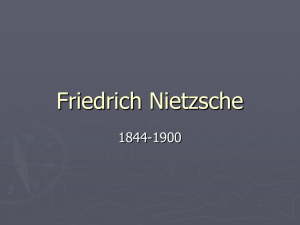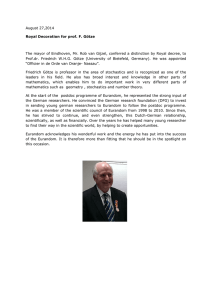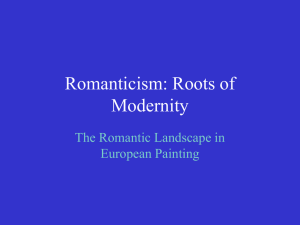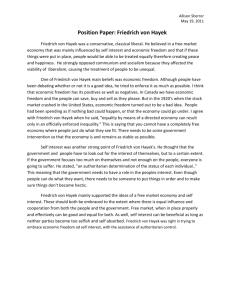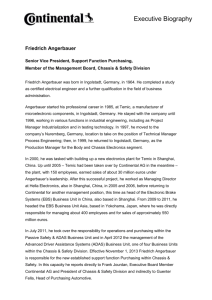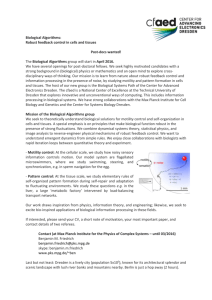As Germany came out from the ashes of World War Two, visions of
advertisement
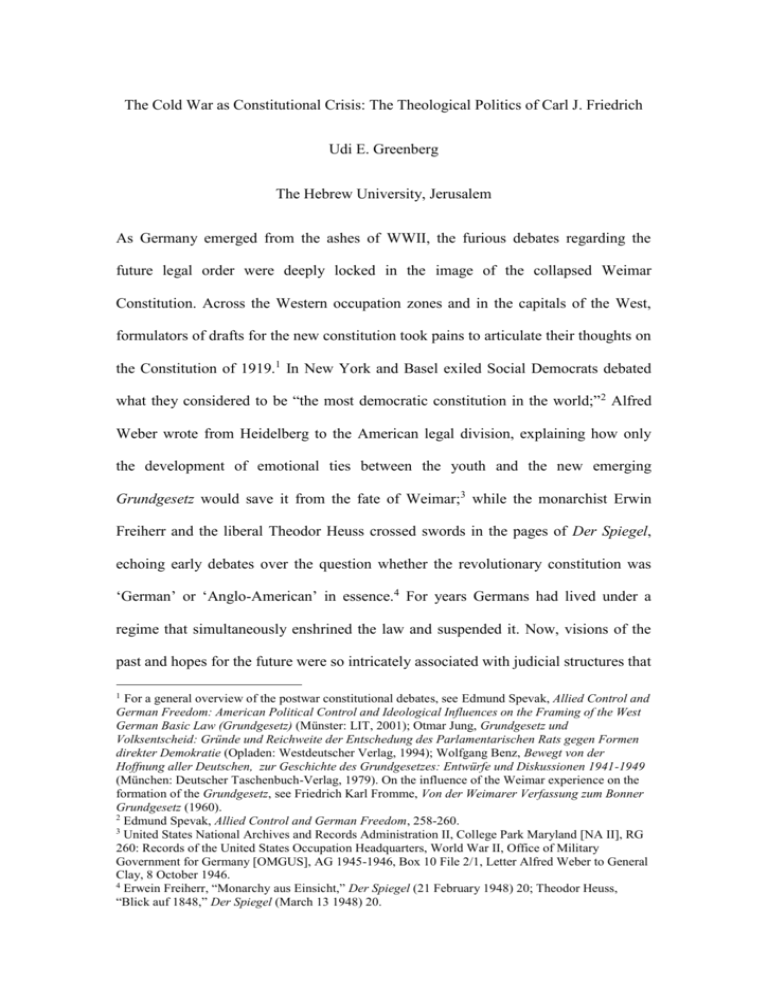
The Cold War as Constitutional Crisis: The Theological Politics of Carl J. Friedrich Udi E. Greenberg The Hebrew University, Jerusalem As Germany emerged from the ashes of WWII, the furious debates regarding the future legal order were deeply locked in the image of the collapsed Weimar Constitution. Across the Western occupation zones and in the capitals of the West, formulators of drafts for the new constitution took pains to articulate their thoughts on the Constitution of 1919.1 In New York and Basel exiled Social Democrats debated what they considered to be “the most democratic constitution in the world;”2 Alfred Weber wrote from Heidelberg to the American legal division, explaining how only the development of emotional ties between the youth and the new emerging Grundgesetz would save it from the fate of Weimar;3 while the monarchist Erwin Freiherr and the liberal Theodor Heuss crossed swords in the pages of Der Spiegel, echoing early debates over the question whether the revolutionary constitution was ‘German’ or ‘Anglo-American’ in essence.4 For years Germans had lived under a regime that simultaneously enshrined the law and suspended it. Now, visions of the past and hopes for the future were so intricately associated with judicial structures that 1 For a general overview of the postwar constitutional debates, see Edmund Spevak, Allied Control and German Freedom: American Political Control and Ideological Influences on the Framing of the West German Basic Law (Grundgesetz) (Münster: LIT, 2001); Otmar Jung, Grundgesetz und Volksentscheid: Gründe und Reichweite der Entschedung des Parlamentarischen Rats gegen Formen direkter Demokratie (Opladen: Westdeutscher Verlag, 1994); Wolfgang Benz, Bewegt von der Hoffnung aller Deutschen, zur Geschichte des Grundgesetzes: Entwürfe und Diskussionen 1941-1949 (München: Deutscher Taschenbuch-Verlag, 1979). On the influence of the Weimar experience on the formation of the Grundgesetz, see Friedrich Karl Fromme, Von der Weimarer Verfassung zum Bonner Grundgesetz (1960). 2 Edmund Spevak, Allied Control and German Freedom, 258-260. 3 United States National Archives and Records Administration II, College Park Maryland [NA II], RG 260: Records of the United States Occupation Headquarters, World War II, Office of Military Government for Germany [OMGUS], AG 1945-1946, Box 10 File 2/1, Letter Alfred Weber to General Clay, 8 October 1946. 4 Erwein Freiherr, “Monarchy aus Einsicht,” Der Spiegel (21 February 1948) 20; Theodor Heuss, “Blick auf 1848,” Der Spiegel (March 13 1948) 20. even private citizens from Munich, Stuttgart and Hamburg flooded the new authorities with their draft constitutions and reflections on Germany’s constitutional history. 5 In these liminal conditions of intellectual and constitutional uncertainty, few exerted as much influence as Carl Joachim Friedrich. A native of Germany from a Calvinist family who moved to Harvard from Heidelberg in 1925, Friedrich became the chief legal advisor to the American occupation in 1947. From this position he emerged as the foremost mediator between the American occupation and the new German political elite, one of the main drafters of the West German Grundgesetz, and one of the key figures in Germany’s democratization. Upon his return to the United States in 1948 he soon became the preeminent spokesman of the theory of Totalitarianism, organizing a series of conferences and publications that crystallized the term for use in the interpretation of modern politics. During the 1950s Friedrich was among the architects of the early European unification and one of the most prominent intellectuals of the early Cold War.6 Yet the tremendous success of the Totalitarianism theory during the early decades of the Cold War was matched only by its rapid fall from grace in later decades, and with it the disappearance of Friedrich from intellectual history. Remembered today mostly by specialists in legal history and scholars of the Cold War, he has vanished entirely from studies of the American occupation, Germany’s reconstruction and postwar European history such as Konrad Jarausch’s After Hitler, Tony Judt’s Postwar or Mary Fulbrook’s History of Germany.7 5 NA II, OMGUS 260, Box XXX File XXX; for a brief discussion of these drafts, see Otmar Jung, Grundgesetz und Volksentscheid. 6 A comprehensive biography of Friedrich has yet to be written. For a partial study, see: Hans J. Lietzmann, Politik Wissenschaft im “Zeitalter der Diktaturen”: die Entwiklung der Totalitarismustheorie Carl Joachim Friedrichs (Oplanden: Leske & Budrich, 1999). 7 Konrad H. Jarausch, After Hitler: Recivilizing Germans 1945-1995 (Oxford: Oxford UP, 2006) trans. Brandon Hunziker; Tony Judt, Postwar: A History of Europe Since 1945 (New York: Penguin Press, 2006); Mary Fulbrook, History of Germany 1918-2000 (Oxford: Blackwell, 2002). 2 Friedrich’s evaporation from the history of modern Germany, accounts of German émigré intellectuals in the United States, and even the role of the German immigration in the Cold War, has relegated his thoughts on German history, politics and theology to almost complete oblivion. Like the rest of his contemporaries, Friedrich dwelled in length on the lessons to be learned from the Weimar Constitution, and his writings to his American supervisors are studded with reflections on its place in German history in general.8 Yet his ideas and historical narrative differed sharply from those of other returning German advisors and intellectuals. The new West German constitution, Friedrich claimed, should improve upon its predecessor by fully adopting the concepts of the forgotten 17th Century Calvinist theologian Johannes Althusius. Althusius, so the argument went, had proposed a perfect model for republicanism and democracy, and in fact should be considered the historical father of German and Anglo-Saxon constitutionalism alike. The Weimar Constitution, according to Friedrich’s narrative, was part of a long chain of attempts to institutionalize such Calvinist principles, the full realization of which was essential to constituting a true democratic order in Germany. Friedrich's invocation of Calvinist theology and his peculiar advocacy of Althusius’ theories as the root of Anglo-German republicanism would have been worthy of attention in their own right as a fundamental aspect of the returning German immigration’s Weltanschauung and the construction of postwar German-American symbolic ties.9 Yet the origin of these ideas sheds light on an even wider, more crucial 8 NA II, RG 260, AG 1947, Box 129, File B15, Report by Carl J. Friedrich to deputy military governor, 28 January 1947. See also: NA II, RG 260, AG 1945, Box 10, File 2/1, Report by Carl J. Friedrich on constitutional history in Germany. 9 For recent literature on the returning German immigration and the democratization of Germany, see Dieter K. Buse, “The 'Going' of the Third Reich: Recivilizing Germans through Political Education,” German Politics & Society 26(1) (Spring 2008) 29-56; Marjorie Lamberti, “Returning Refugee Political Scientists and America's Democratization Program in Germany after the Second World War,” German Studies Review 31(2) (May 2008) 263-284; Alfons Soellner, “Die Emigration im Kontext - 3 and more puzzling phenomenon, namely, the troubled afterlife of the Weimar period. For Friedrich, who was born in 1901, the defining years of intellectual development were those of the Weimar Republic. As a student of Alfred Weber until 1925 and an interlocutor for Germany’s most important legal scholars during the early thirties,10 Friedrich developed and published his ideas on Althusius and the role of Calvinist theology already during the last years of the republic, and his postwar political and theological theories can in many ways be understood as an extension and continuation of his Weimar thought. In fact, these early works reflect an important yet often-neglected aspect of Weimar’s discussions on politics and theology. Scholarship has paid much attention to the role of theology and eschatology in the works of conservative, revolutionary and radical political thinkers, yet more moderate, democratic traditions of theological politics have received far less scrutiny.11 The example of Friedrich, therefore, sheds light both on the role of theology in republican political thought in the Weimar period, and on the process whereby ideas from Weimar’s constitutional debates survived dramatic changes and catastrophic experiences only to reappear in entirely new contexts. As Eine Skizze zur politischen Ideengeschichte des 20. Jahrhunderts,” Harald Bluhm & Jürgen Gebhardt (eds.), Politische Ideen im 20. Jahrhundert: Konzepte und Kritik (Baden-Baden: Nomos, 2006) 181197; Alfons Soellner, “Normative Westernalization? - The impact of Remigrés on the Foundation of Political Thought in Post-War Germany,” Jan-Werner Müller (ed.) German Ideologies since 1945: Studies in the Political Thought and Culture of the Bonn Republic (New York: Palgrave Macmillan, 2003) 40-60. 10 Friedrich's surviving correspondence with Richard Thoma, Hans Kelsen, Rudolf Smend and the SPD judicial expert Arnold Brecht, with whom he was especially close, dates mostly from 1933 onward, yet the letters indicate an earlier familiarity. For the exchange with Thoma, see Harvard University Archive, Carl J. Friedrich Papers (HUGFP) 17.6 Box 40 File TUV 1933; with Kelsen: HUGFP 17.31 Box 1 File American Committee for Guidance 1938-1939; with Smend: HUGFP 17.6 Box 37 File S 1932-3; and with Brecht, see for example: HUGFP 17.39.5 Box 1 File B. 11 See for example: Anson Rabinbach, In the Shadow of Catastrophe: German Intellectuals Between Apocalypse and Enlightenment (Berkeley: U of California P, 1997); Yotam Hotam, Modern Gnosis and Zionism: The Crisis of Life, Lebensphilosophie, and National Jewish Thought (Magness: Jerusalem, 2007) [Hebrew]; Benjamin D. Crowe, Heidegger’s Religious Origins: Destruction and Authenticity (Bloomington and Indianapolis: Indiana UP, 2006); Peter Eli Gordon, Rosenzweig and Heiddeger: Between Judaism and German Philosophy (Berkeley: U of California P, 2003). 4 applied to the new international politics and historical narratives, I will argue, these old terms helped to define the intellectual world of the early Cold War. Friedrich’s thought, however – and this constitutes my second argument - was shaped not only in light of the abstract Weimar Zeitgeist, but also, and more importantly, through a continuous dialogue with Carl Schmitt. His Cold War theories of democracy, dictatorship, representation, totalitarianism and theology should be understood within this dialog and in light of Schmitt’s crucial influence on the young Weimar intellectual. During the late 1920s and the 1930s, the future agent of democratization and the arch-conservative thinker not only shared intellectual and political stands, but developed an intense friendship that at times seemed to have almost father-son qualities. Friedrich’s writings from this period are crammed with expressions of admiration for Schmitt’s “epoch-making” writings,12 and in one of his letters to Schmitt, in which he sought his opinion on a draft of his work, Friedrich wrote “I care about no-one’s opinions but yours.”13 Schmitt, in return, was supportive of Friedrich and invested much effort in introducing him to Germany’s judicial elite. He arranged Friedrich’s guest professorship in Heidelberg in 1933,14 and Friedrich was designated as translator of Schmitt’s Die Diktatur to English and would introduce him to the American audience.15 This in itself was not unusual among democratic and even Socialist intellectuals,16 yet the correspondence and exchange of ideas between See for example: Carl J. Friedrich, “Dictatorship in Germany?” Foreign Affairs 9(1) (October 1930) 118-132. 13 Hauptstaatsarchiv Düsseldorf [HStAD], Nachlass Carl Schmitt RW 265-4422 Letter Friedrich to Schmitt 18 January 1932. 14 HStAD RW 265-4425, Letter Carl J. Friedrich to Carl Schmitt, 2 December 1932; RW 265-XXX, Letter Carl Schmitt to Walter Jelinek, 16 June 1932. 15 See for example: HUGFP 17.6 Box 37 File S 1932-3, Letter Carl J. Friedrich to Carl Schmitt, 2 December 1932; HUGFP 17.6 Box 37 File S 1932-3, Letter Carl J. Friedrich to Carl Schmitt, 17 January 1933; HUGFP 17.6 Box 37 File S 1931, Letter Carl Schmitt to Carl J. Friedrich, 24 May 1930; HUGFP 17.6 Box 9 File D 1932, Letter Duncker & Humblot to Carl J. Friedrich 24 December 1932. 16 See for example, William E. Scheuerman, Between the Norm and the Exception: The Frankfurt School and the Rule of Law (Cambridge, Mass.: MIT P, 1994). 12 5 the two men continued after the Nazi rise to power and well into the Cold War. After a long break, Friedrich resumed their friendship with a letter in 1958, and from that point on their correspondence shows that the two often met, consulted over academic matters and exchanged drafts and ideas.17 It seems that Schmitt grew ever more attached to Friedrich’s work, and letters show that even after he sold his library in 1955 as a result of financial difficulties, not only did he keep Friedrich’s books, but he also refused to lend them to his students and friends.18 Though seemingly contradictory at first glance, Friedrich's relationship with Schmitt and his attempt at constructing a democratic, “Calvinist” postwar Germany that would root out totalitarian sentiments is closely connected. As demonstrated below, these personal relations were more than merely anecdotal, and served as a basis for an ongoing exchange of ideas in which both Schmitt and Friedrich borrowed from and responded to each other. In this sense, the scholarship on Schmitt and his reception could likewise be enriched by devoting more attention to Friedrich. 19 For Friedrich, as much as it was a confrontation with the Soviet Empire and the creation of the German-American bond, the Cold War was also a confrontation with the German reactionary thinker. Thus, even though it attained its greatest influence only decades later, Friedrich’s thought represents the inner tensions and struggles of one of the most important, and most neglected, offshoots of the Weimar moment. 17 See for example: HStAD RW 265-4426, Letter Carl J. Friedrich to Carl Schmitt, 2 July 1957; RW 265-4428, Letter Carl J. Friedrich to Carl Schmitt, 11 July 1958; RW 579-98, Letter Carl J. Friedrich to Carl Schmitt, 16 June 1959; RW 579-98, Letter Carl Schmitt to Carl J. Friedrich, 24 June 1959; RW 265-4429, Letter Carl J. Friedrich to Carl Schmitt, 6 July 1959. 18 See for example: HStAD RW 265-10604 Letter from Marjorie N. Robbins, The Foreign Service of the United States of America, to Carl Schmitt, 18 September 1953; RW 265-12979, Letter Carl Schmitt to Forsthoff, 29 April 1954; RW 265-13105, Letter Carl Schmitt to Dr. Boller, 9 February 1955. 19 In Jan-Werner Müller’s recent ambitious study of Schmitt’s reception in Europe and the United States, for example, Friedrich receives but one sentence: Jan Werner Müller, A Dangerous Mind: Carl Schmitt in Post-War European Thought (New Haven: Yale UP, 2003) 2. 6 1. From Schmitt’s Die Diktatur to Friedrich’s Totalitarian Dictatorship As a student of Alfred Weber in Heidelberg, Friedrich came from a tradition of an elitist, ‘aristocratic’ republicanism and support for strong executive powers.20 In lectures on the Weimar Constitution that he gave in the United States in 1926, for example, the role of the president was interpreted as a bulwark against the potential tyranny of the unrestricted parliament.21 It was from this perspective that he became fascinated by Schmitt’s theory of dictatorship. In this famous 1921 Die Diktatur, Schmitt claimed that in a state of emergency the constitutional order offers two kinds of dictatorship – the commissarial dictator, who derives his power from the constitution, safeguards it and restores it; and the sovereign dictator, who acts to create a wholly new order.22 Sovereign dictatorship, Schmitt's historical narrative asserted, appeared in modern times with the French revolution, with its ideas of popular sovereignty and rational, technical conduct of society. It therefore reflected democracy’s inner contradictions and inherent instability: “The people, the nation, the original power of all state essence,” he wrote, “constitutes ever new organs. From the infinite, inconceivable abyss of its power arise ever new forms, which it can smash at any time and in which its power is never definitively delimited.”23 Commissarial dictatorship, on the other hand, had originated several centuries earlier and echoed Christian principles of sovereignty. It was therefore not a simple despotism, as “bourgeois political literature” claimed, but a concrete situation in which the sovereign suspended law to take concrete measures to restore the legal order.24 Since the sovereign, as he later claimed, was defined by the right to proclaim a “state of 20 Lietzmann, 29-46. HUAFP 17.60 Box 8 File “The German Constitution 1919,” lecture in South Carolina 1926. 22 Carl Schmitt, Die Diktatur, von den Anfängen des modernen Souveränitätsgedanken bis zum proletarischen Klassenkampf (Berlin: Duncker & Humblot, 1921). 23 Ibid., 142. 24 Ibid., xii. 21 7 exception,” the option of dictatorship was inherent to the idea of sovereignty and to the political order and could be realized in times of instability. With the onset of the political and constitutional crisis that beset Germany in 1930, as is well known, this theory took on crucial importance. Hindenburg’s suspension of parliamentary rule and its replacement by presidential government made the interpretation of Article 48 and the limits of presidential dictatorship a matter of pressing urgency. It was then that Friedrich aligned himself with Carl Schmitt and his advocacy of the president’s supremacy as “the guardian of the Constitution,” and initiated the translation of Die Diktatur to English.25 As Carl Schmitt “has shown convincingly,” Friedrich wrote in 1930, the president encompassed the united will of the nation, and as such was superior to a “system of proportional representation with its multiple party groups and the resulting lack of a coherent majority.” The Constitution, Friedrich claimed, has clearly granted the president the right to steer the country in times of crisis, and as such he had the final word on all constitutional and political decision-making. “Germany might well be congratulated,” he concluded, “for the wisdom of its constitution-makers,” who had enabled the president to declare a state of exception and the formation of a commissarial dictatorship.26 When the constitutional crisis reached its peak with chancellor von Papen’s Preussenschlag against the social-democratic government of Prussia, and Germany’s judicial elite clashed over the legality of the presidential decree,27 Friedrich continued to support Hindenburg and congratulated Schmitt on his appearance as the federal government’s representative in the Supreme Court. Even the Nazi rise to power within the 25 HUGFP 17.6 Box 37 File S 1931, Letter Carl Schmitt to Carl J. Friedrich, 24 May 1930. Carl J. Friedrich, “Dictatorship in Germany?” 130-132; See also Carl J. Friedrich, “The Development of Executive Power in Germany,” American Political Science Review 27 (1933) 203; Carl J. Friedrich, “National Socialism in Germany,” Political Quarterly 1 (1932) 520-530. 27 Peter C. Caldwell, Popular Sovereignty and the Crisis of German Constitutional Law: the Theory and Practice of Weimar Constitutionalism (Durham: Duke UP, 1997) 164-170. Dietrich Orlow, Weimar Prussia, 1925-1933: The Illusion of Strength (Pittsburgh: Pittsburgh UP, 1991). 26 8 constitutional framework, despite Friedrich’s hostility to their methods and racist ideology, did not seem to stir in him any sense of urgency. Like many others, in spring 1933 he still predicted that Hitler too would soon submit himself to the presidential order and would eventually “calm down.”28 Yet as David Dyzenhaus, Peter Caldwell and others have noted, Schmitt formulated his theory of dictatorship in a “dual style.”29 His discussion of Article 48, which presented itself as guidance for the preservation of the constitutional order, in fact encompassed also its suspension. In his Political Theology he distinguished between a limited state of siege and an existential threat to the political existence of the state. In the latter case, Schmitt asserted, the president was to receive full powers and suspend all legal norms. “The existence of the state,” he wrote, “is undoubted proof of its superiority over the validity of the legal norm… The state suspends the law in the exception on the basis of its right of self-preservation.”30 The crisis of the early thirties, according to Schmitt, presented precisely such a threat. The multiplicity of social and political organizations that clashed with each other, he claimed, was a direct result of the multi-party system, which had lost its ability to unite the nation within one political framework and was leading Germany to the verge of selfdestruction. The option whereby the president would adopt the role of sovereign dictator and eliminate the liberal-individual component of the constitution was therefore insinuated in Article 48 itself. Furthermore, and equally crucial to the development of Friedrich’s work, was Schmitt’s claim that modern states were forced to take part in the economic process. Carl J. Friedrich, “The Situation in Germany,” Harvard Alumni Bulletin (1933) 348-351. Caldwell, Popular Sovereignty, 208; David Dyzenhaus, Legality and Legitimacy: Carl Schmitt, Hans Kelsen and Hermann Heller in Weimar (Oxford: Clarendon P, 1997); See also: Ellen Kennedy, Constitutional Failure: Carl Schmitt in Weimar (Durham: Duke UP, 2004). 30 Carl Schmitt, Political Theology (Cambridge, Mass.: MIT P, 1985) trans. George Schwab, 12. 28 29 9 Modern states, he claimed in Legality and Legitimacy, faced the choice between being a “weak total state,” such as the Weimar Republic, in which the economy is controlled by interest groups, and a “strong total state,” in which the state would put an end to social unrest by assuming control over the key economic organs, thereby dissolving the distinction between society and state.31 The political and legal order that he foresaw would, therefore, not only dissolve the parliament and abolish individual rights; it would become a new “total state.”32 For Friedrich, the consequences of Schmitt’s “dual” thinking gradually came to represent the dangers of modern politics, as well as the core of what would later be termed totalitarianism. Observing Mussolini’s invasion of Ethiopia, the beginning of the show trials in Moscow and the declaration of the Nazi Four Year Plan in 1936, Friedrich began to believe that Europe’s new regimes presented something novel that could not be explained within the framework of commissarial dictatorship. “[T]he doings of the Nazis,” he wrote, “make me look like a fool… I am quite frank to own that I never expected such a violent attack upon the fundamentals of our culture.”33 National Socialism and Communism’s easy slide from limited dictatorship to an entirely new legal order, according to this view, reflected Schmitt’s assertion that sovereign dictatorships were locked in the paradox of creating a continually changing political mechanism, “which it can smash at any time and in which its power is never definitively delimited.” The inherently unstable character of such regimes due to the lack of constitutional boundaries, Friedrich warned, gave birth to a predatory, aggressive impulse that could not be contained within the old international system. 31 Carl Schmitt, Legality and Legitimacy (Durham & London: Duke UP, 2004) trans. Jeffrey Seitzer 85-94. 32 Carl Schmitt, ‘Weiterentwicklung der totalen Staats in Deutschland,’ Verfassungrechtliche Aufsätze aus den Jahren 1924-1954: Materialien zu einer Verfassungslehre (Berlin, 1958 [February 1933]), esp. 359-360. 33 Quoted in Lietzmann, p. 257, ff. 563. 10 Indeed, in 1938 he clearly stated that foreign policy was determined not by a country's power or economic interests, but by its constitutional structure. As a projection of their inner principles, Friedrich claimed, Western powers by their very nature sought to shape the globe in their own constitutional form, that is, as a system of checks and balances between world powers. Fascist, Nazi and Communist aggression, on the other hand, was inherent to their perverse anti-constitutional character. What the world was facing, he warned his American readers in 1938, was an inevitable clash that could be only understood as a “global civil war.”34 These disparate kinds of constitutional and unconstitutional order could not coexist, and their collision was bound to end in a war of total annihilation that could only be compared to the European wars of religion.35 Though this aspect cannot not be further developed here, it is interesting to note that Schmitt responded by adopting and then turning both of Friedrich’s analogies against the Americans. After WWII Schmitt claimed that it was the American “space-less universalism” (raumlos Universalismus) that marked the transformation of both world wars from limited, “normal” political conflicts to a “global civil war.” In fact, the entire historical narrative that he developed in his 1950 Nomos of the Earth was based on the analogy of American intervention as the reincarnation of the wars of religion.36 Giorgio Agamben’s attribution of the notion of “global civil war” to Schmitt’s postwar thought, therefore, missed the historical roots of its polemic interlocutor.37 As clouds were gathering above Europe’s sky, the inability to demarcate the borders between the two kinds of dictatorship in a state of exception became, in Friedrich’s 34 Carl J. Friedrich, Foreign Policy in the Making: the Search for a New Balance of Power (New York: W. W. Norton, 1938) 223 ff. 35 Ibid., 48, 236 ff.. 36 Carl Schmitt, Nomos of the Earth: the International Law of the Jus Publicum Europaeum (New York: Telos, 2003) trans G. L. Ulmen. 37 Giorgio Agamben, State of Exception (Chicago: U of Chicago P, 2005) trans. Kevin Attell, 3. 11 eyes, the most acute political issue of modern politics. Since the commissarial type encompassed the sovereign dictatorship, he claimed in his 1937 Constitutional Government and Politics, “there are no ultimate institutional safeguards available for insuring that emergency powers be used for the purpose of preserving the Constitution.” Since the most destructive danger faced by constitutional orders was inherent in the emergency situation envisaged by the constitutions themselves, “[on]ly the people’s own determination to see them so used can make sure [they will protect the Constitution]… We must conclude, therefore, that all in all the quasi-dictatorial provisions of modern constitutional systems... [such as] constitutional emergency powers, fail to conform to… the political implications of even a temporary concentration of powers. Consequently, we must conclude that all these [constitutional] systems are liable to be transformed into absolutist schemes, if conditions become… favorable to it… Constitutional government,” he sadly concluded, “is weak.”38 As inherent to the constitutional order, the limitation of emergency powers and dictatorships remained a problem also after the victory over Nazism. While consulting General Clay in 1947 and 1948 and working on the drafts of the Grundgesetz, Friedrich characterized the difference between the American and the Soviet occupations of Germany as the difference between constitutional and sovereign dictatorships.39 His insistence on a rapid transfer of power to the Germans, for example, stemmed from the conviction that the limitation of the emergency situation in time was the key mechanism in preventing American rule from deteriorating into 38 Carl J. Friedrich, Constitutional Government and Politics: Nature and Development (New York: Harper, 1937) 220. 39 Carl J. Friedrich, “Organizational Evolution in Germany 1945-1947,” in Carl J. Friedrich (ed.) American Experiences in Military Government in World War II (New York: Rinehart, 1948) 197-210. 12 non-constitutional dictatorship. According to this conceptual framework, the Soviet occupation was indeed a mere continuation of the Third Reich. The most famous and most complete reformulation of Schmitt’s theory, however, appeared in 1953, with the theory with which - despite his objections - Friedrich remained associated and which brought him to the forefront of the intellectual Cold War, namely, the theory of totalitarianism. An umbrella term for many different and at times contradictory theories, which amalgamated the work of diverse thinkers such as Theodor Adorno, Hannah Arendt, Friedrich Hayek and Zbigniew Brzezinski, the theory of totalitarianism has often been dismissed as simplistic Cold War polemic. It has often, as in the work of Abbott Gleason and William David Jones, been reduced to the mere coupling of Nazism and Communism as a single phenomenon.40 The unique terminology that comprised Friedrich’s theory, as well as its historical roots, has thus sometimes been blurred and lost. Yet as Hans Lietzmann has noted, totalitarianism for Friedrich had a very distinctive characteristic.41 It was defined neither as totalist ideology, nor as the sacralization of politics, nor, as Hannah Arendt put it, the destruction of all traditional ties.42 According to Frierich's model, the transition of the state of emergency into a permanent condition and the slide from commissarial into a sovereign dictatorship gave birth to the new pathological regime only through the government’s economic control, that is, once society had been completely absorbed by the state. 43 It is only in this light that one can understand his claim that it was the year 1936, with the Nazi 40 William David Jones, The Lost Debate: German Socialist Intellectuals and Totalitarianism (Urbana: U of Illinois P, 1999); Abbott Gleason, Totalitarianism: the Inner History of the Cold War (New York: Oxford UP, 1995). 41 See Lietzmann, 137-139. 42 Hannah Arendt, The Origins of Totalitarianism (New York: Schocken, 1951). 43 Carl J. Friedrich and Zbigeniew K. Brzezinski, Totalitarian Dictatorship and Autocracy (Cambridge, Mass.: Harvard UP, 1956). 13 Four Year Plan, and not an earlier date, that marked Germany’s transformation into totalitarianism. It was, therefore, only once the “weak total state,” to use Schmitt’s formulations from 1932, has become a “strong total state,” that totalitarianism emerges. Thus, although Friedrich maintained close personal ties and friendships with other spokesmen of the theory of totalitarianism such as Hannah Arendt and Jacob Talmon, the differences in their intellectual background left his definitions of the phenomenon clearly distinct from theirs.44 What is more important, for Friedrich “totalitarianism” was not at all, as is often claimed, a term coined to join together the enemies of the West. What evaded many scholars’ attention was Friedrich’s notion that this concept marked the constant danger inherent in the constitutional order, against which the West was struggling. It stemmed from the belief that the Western constitutional regimes themselves, with the commissarial dictatorship inherent to their concept of sovereignty, were permanently endangered by the potential slide into a “strong total state.” From the late thirties and into the forties, Friedrich therefore initiated a flood of publications, lectures and political rallies throughout the East Coast aimed at strengthening the American people’s “spirit of democracy” in the face of democracy’s inner threats.45 As revealed by pamphlets he composed for the Council for Democracy, a group of intellectuals that had formed in Boston, Friedrich believed that the United States under Roosevelt was facing dangers similar to those of Weimar that could facilitate its transformation 44 Though this has not received much attention from Arendt scholars, the correspondence between the two reveals close and friendly relations that went beyond the professional and intellectual spheres. See for example: HUGFP 17.60 Box 22 File B, Letter Hannah Arendt to Carl J. Friedrich August 6 1954, and Letter Friedrich to Arendt, 8 August 1954. Following his visit to Jerusalem in 1946, Friedrich became close to the historian Jacob Talmon and thought highly of his theory of “totalitarian democracy.” Talmon was in Harvard when Friedrich developed his theory of totalitarianism and the two remained in touch throughout the fifties and sixties. For their correspondence, see, for example HUGFP 17.14 Box 27 File Talmon. 45 For a report on some of these activities, see: Carl J. Friedrich, The Poison in Our System (New York: Council for Democracy, 1942). See also: HUGFP 17.24 Box 7 File Rally 1942. 14 into a totalitarian regime.46 It was this fear that drew him after the war to the young Richard Nixon and his Committee for anti-American Activities in 1948,47 and that guided the long and continuous relationship with his most famous student, Henry Kissinger.48 The struggle against Nazism and later Communism, that is, was for Friedrich at the same time aimed at saving the constitutional regime from itself. Totalitarianism, therefore, was to be read according to Friedrich within the tradition of Western political theory. Thus if, as Schmitt claimed, all concepts of modern political thought were secularized theological terms, then totalitarianism too was to be understood within the Western and Christian framework. Thus, at the famous conference on the totalitarian phenomenon that Friedrich convened at Harvard in 1953, which brought together scholars and politicians such as Hannah Arendt, George Kennan, Arnold Toynbee, Erik Erikson and, though only as a listener, Isaiah Berlin, one finds his repeated reminders that totalitarianism should be regarded not as part of the German, Russian or Chinese traditions, but as a European phenomenon based on Christian ideas.49 The fact that totalitarian regimes could have developed in China and Russia, according to this view, was to be understood as an import of Western ideas by these countries’ political elites. It was only through their agency that nations could reach the stage of “strong total states” and enter into a permanent state of exception. The struggle between the United States and the Soviet Empire, therefore, was to be 46 HUGFP 17.24 Box 5 File Council for Democracy Memo; HUGFP 17.24 Box 7 File The New World – The New World Pamphlet 1942. 47 HUGFP 17.39.5 Box 1 File Correspondence G, Letter Carl J. Friedrich to Richard Nixon, 11 May 1948. 48 Kissinger was not only Friedrich’s student, but also the young editor of his joint book with Brzezinski on totalitarianism. The two remained in touch throughout Kissinger’s academic and political career, and Friedrich collected press clippings of Kissinger’s remarks on totalitarianism. For their correspondence on Friedrich’s book, see: HUGFP 17.12 Box 9 File Common Man; for other correspondence, see: HUGFP 17.14 Box 18 File Kissinger, Henry; HUGFP 17.60 Box 22 File K. 49 See for example: HUGFP 17.16 Box 8 File Totalitarian Conference Discussions, Sixth Panel Discussion, p. 6. See also Carl J. Friedrich “The Unique Character of Totalitarian Society,” idem. (ed.) Totalitarianism (Cambridge, Mass.: Harvard UP, 1954) 47-60. 15 perceived through the concepts of Schmitt’s theories, and the Cold War was to be observed through the experience of the late Weimar and early Nazi constitutional crisis. 2. Friedrich’s Theological Politics and Weimar’s Political Theology Although the transformation in Friedrich’s thought evolved within the framework of Schmitt’s concepts, his fierce hostility to totalitarianism’s “perverse” legal and political nature seems to be at odds with the warm relations he resumed in 1958 with its most vocal and dangerous advocate. Furthermore, on the less personal and more intellectual level, this transformation can hardly explain Friedrich’s recourse to Calvinist theology and political philosophy as the model for Germany’s postwar reconstruction, and as the origin of the West’s political thought in general. These seemingly contradictory components appear far more coherent when observed as part of an ambitious attempt at formulating an alternative theory of democracy that would not be based on the liberal, individual ideas of the Enlightenment. Like many others, Friedrich believed that such an alternative source of political legitimacy could only be found in theology, or more precisely, in the clarification of the relations between theology and political theory.50 Yet his suggestion was radically different to those generally associated with the term “political theology.” Though overshadowed by scholarship’s attention to his theory of totalitarianism, this aspect of his work was valued far more by Friedrich himself. As in the case of his thoughts on totalitarianism, 50 For recent literature on this topic, see: Hent de Vries and Lawrence E. Sullivan (eds.) Political Theologies: Public Religions in a Post-Secular World (New York: Fordham UP, 2006); Nitzan Lebovic (ed.), special issue on Political Theology, New German Critique 105 (Forthcoming, fall 2008). 16 the roots of Friedrich's specific version of political-theological theory are to be found in Schmitt’s early-Weimar writings. The main weaknesses of republican political theory, according to Friedrich, were most clearly identified in Schmitt’s Roman Catholicism and Political Form. In this polemical essay written in 1923, which Friedrich enthusiastically called “a brilliant piece,”51 Schmitt claimed that a coherent, functioning political regime could not base itself on Enlightenment’s rationality without reliance upon pre-modern, transcendental sources of authority. Though such sources did not necessarily have to be theological, since “the nation,” too, could function as such a source, they did of necessity require a transcendental quality and an aura of “dignity.” Such objects and the political systems that give them a tangible form, Schmitt claimed, need to have reciprocal relations analogous to those between God and the Catholic priest, in the sense that the priest, through the religious ritual, renders the divinity present. The basic difference between modern political regimes, Schmitt therefore concluded, was their ability or inability to represent, that is, to impart material reality to transcendental objects such as “the nation.”52 Liberalism and Bolshevism, according to Schmitt, were twin soulless, technologicaleconomic systems, which observed all objects as equally materialistic, and therefore could represent nothing beyond them. As he later wrote in Constitutional Theory, “[s]omething dead, something inferior or valueless, something lowly, cannot be 51 Quoted in Lietzmann, p. 245 ff 533. Carl Schmitt, Roman Catholicism and Political Form (Westport, Conn.: Greenwood Press, 1996) trans. G.L. Ulmen. On the relation between Schmitt’s theory of representation and his support of presidential dictatorship, see Duncan Kelly, “Carl Schmitt's Political Theory of Representation,” Journal of the History of Ideas 65(1) (January 2004), 113-134; John P. McCormick, Carl Schmitt’s Critique of Liberalism: Against Politics as Technology (Cambridge: Cambridge UP, 1997) 157-205. 52 17 represented.”53 Parliamentarianism, with its internal quarrels and divisions, could not conjure up the undivided, transcendental nation. Thus, the only political system that could reproduce the Catholic model and its “theological” authority was some type of a plebiscite dictatorship. By contrast to Calvinist individualism and materialism, which Schmitt identified as the Godfather of modern economics, the destroyer of the Political and Catholicism's “real opponent,”54 only the Catholic Church and its secular equivalent, the presidential dictatorship, could offer a viable political model. If democracy was to gain legitimacy and be freed from formless, individualistic, liberal principles, Friedrich claimed during Weimar’s final years, it would have to be shown to rely on non-individualistic and transcendental sources of authority. “Pure” theory of law, such as that of Hans Kelsen, or the rational enshrining of individual rights, could not provide a response to Schmitt’s challenge. The key to such new legitimacy, Friedrich maintained, was to be found in Calvinist political thought. According to this claim, both Schmitt and Max Weber had been wrong to associate the Calvinist spirit with the birth of the economic-individualistic modern world. The implications of Calvin’s revolution could not be limited to the indirect creation of capitalistic materialism, the profit motive and, as Schmitt saw it, the catastrophic blending of politics and economy. Weber’s famous theory, according to Friedrich, in fact embodied dangerous consequences as it drew historical and theoretical attention to the economic derivatives of Calvinism, thereby creating unnecessary dichotomies and eclipsing its potential to serve as a model for political organization. The most promising political model was to be found, as Friedrich saw it, in the early 17th Century thinker Johannes Althusius and his monumental book Politica Methodice 53 Carl Schmitt, Constitutional Theory (Durham and London: Duke UP, 2008) trans. Jeffrey Seitzer, 243. 54 Schmitt, Roman Catholicism, 87. 18 Digesta, which Friedrich sought to revive from oblivion and republished in 1932.55 Politica, he believed, suggested an alternative model to republicanism that would still conform to Schmitt’s definition of the Political. In Althusius’ work, Friedrich claimed, which was even more important than that left by Hobbes and Lock, politics was for the first time discussed as a field in itself, with its own logic and terminology. Centuries before Schmitt, Althusius identified the tendency to blend political discourse with economic, aesthetic and other terminologies, and sought to cleanse the political in order to enable the construction of a just political order. “[E]conomics and politics,” Althusius warned confused readers, “differ greatly as to subject and end.”56 This Calvinistic order, Friedrich explained, took the family and the small community as its basic units, and its political life was to be organized in a series of social layers within expanding groups.57 A collection of families was to form the council of the village, which in its turn would be represented in the council of the province. A collection of provinces, in its turn, was to form a commonwealth, and so forth up to the council of the empire, which would constitute a union of Länder and free cities. Political representation, however, was not to be based in Althusius’ model on simple homogeneity. Each council would comprise heterogeneous and flexible combinations of groups; the city council, for example, would be composed not only of families, but would include also representatives of the guilds and other organizations; the council of the empire would be composed of representatives of cities, provinces and other groups. The only associations that contained the inherent quality of piety were those of the family and the small community, and it was only within their boundaries that a 55 Johannes Althusius, Politica Methodice Digesta, Reprinted from the Third Edition of 1614 (Harvard: Harvard UP, 1932). For more recent assessments of Althusius’ theory, see for example: Thomas O. Hueglin, Early Modern Concepts for a Late Modern World: Althusius on Community and Federalism (Waterloo: Wilfrid Laurier UP, 1999). 56 Johannes Althusius, The Politics of Johannes Althusius (London: Eyre & Spottiswoode, 1964) trans. Frederick S. Craney, 27. 57 Carl J. Friedrich, “Johannes Althusius and his time,” in Althusius, Politica, XXX. 19 truly Christian community could be preserved. It was only they, and not the king, who had the authority to make the supreme political decision and, like God, had constituting power (potestas constituta). The king, like any individual, was potentially impious, and the communities represented on the council would thus always have the right to replace him and guarantee the pious order. Yet this was not to say that power relations within the communities were to be conducted on a basis of equality, which created only “disorder and disturbance.” The basic principle for the establishment of what Althusius saw as just political relations would be “fairness (aequabilitas)” among the different groups within the community, “when right, liberty and honor are extended to each citizen according to the order and distinction of his worth and status.”58 The importance of Althusius’ model, according to Friedrich, was two-fold. First, it suggested a republican model of representation that was based on non-individualistic principles, and could therefore conform to Schmitt’s views on politics as antiindividualistic in essence. Not only was the individual not the basic unit in this model, but he in fact “disappeared” within it, Friedrich wrote, and gained importance only through his participation in groups. His political activity was carried out “not as an individual, but only as a representative (Repräsentant) of the sub-consociatio to which he belongs, as pater familias or head of the guild (Gildmeister) for example.”59 Each group was thus to be represented at several levels and in different ways, which were always open to negotiation and change. The family, for example, was to be represented in the village, and again in the guild or the province. This political 58 Althusius, The Politics, 44. Carl J. Friedrich, Johannes Althusius und seine Werk im Rahmen der Entwicklung der Theorie von der Politik (Berlin: Duncker und Humblot, 1975) 120-121. 59 20 layering enabled parallel and simultaneous representation for groups and organizations at all levels. Friedrich therefore differed considerably from other individualist, anti-totalitarian thinkers such as Hayek or Arendt. As for Schmitt, Friedrich insisted that the individual could not be a constituting unit as far as political participation was concerned. He or she became important only as a member of an assembly,60 and the importance of Althusius’ Calvinist model lay in its reliance not only on the state, but on a series of crisscrossing and heterogeneous groups that formed the institutions of the political sphere. In fact, in his Constitutional Government he claimed that real political representation was born for the first time during the Reformation on German soil.61 Thus, even though Althusius received some scholarly attention during the Weimar period in the works of Otto von Gierke and others,62 with Friedrich it was the first time – and probably the last – that his works were both to be understood as the historical origin of constitutional democracy and to serve as the model for modern political organization. Multi-layered Democracy, composed of closely-knit complex groupings, offered a representative alternative to Schmitt’s “Catholic” dictatorship. Second, and more important, Althusius offered for Friedrich a model for democratic order that was based not on the secular doctrines of the Enlightenment, but on a religious Bund. In fact, he claimed, all the principles of constitutional and democratic order were based on Christian concepts.63 Althusius, Friedrich asserted, had shown how not only the nation or the Church, but first and foremost communities of 60 See this notion also in Carl J. Friedrich, The New Belief in the Common Man (Boston: Little, Brown & Co., 1942) 61 Friedrich, Constitutional Government and Politics: Nature and Development, 258-259. 62 Otto von Gierke, Johannes Althusius und die Entwicklung der naturrechtlichen Staatstheorien (Breslau: Verlag von M. & H. Marcus, 1929). Schmitt also mentions Althusius briefly in Constitutional Theory, 126. 63 Carl J. Friedrich, Transcendent Justice: The Religious Dimension of Constitutionalism (Durham: Duke UP, 1964); see also: Carl J. Friedrich, “Preface,” in Althusius, The Politics, viii. 21 changing sizes, were invested with the divine right to produce law and rule themselves, and give form to their transcendental qualities. Thus the inner divides and tensions so characteristic of the republican regime were not to be regarded as materialistic forces contradicting the “theological” coherence of the nation, the result of what Weber saw as the secularizing “disenchantment” of modernization. Like Schmitt’s plebiscite dictatorship, they were a type of secularized political form that preserved the “dignity” and quality of the religious period. Catholic dogma, therefore, should not serve as the only model for political form. The religious roots of the republican phenomenon had been exposed, and Schmitt’s attack on republicanism could be overcome. It was in this spirit, in a letter from 1931 to thank Schmitt for the copy of der Hütter der Verfassung, that Friedrich promised to send his soon-to-bepublished book on Althusius “as a response to your ideas.”64 Yet one should understand Friedrich’s writings on theological politics also against the background of wider debates on the nature of the relations between theology and politics that took place during the Weimar period, and that in their turn echoed even earlier theological-intellectual traditions.65 The attempts at finding a theological source for political legitimacy or action, as well as the interpretation of modern politics as based on theological concepts, stretched from Right to Left, and included political theorists and theologians alike. In Göttingen, for example, theologian Emanuel Hirsch linked Christian faith to nationalistic and anti-democratic, and eventually Nazi politics,66 while in Münster and Bonn Karl Barth developed a more 64 HStAD, RW 265-4420 Letter Carl J. Friedrich to Schmitt, 2 August 1931. Alf Christophersen, Kairos: Protestantische Zeitdeutungskämpfe in der Weimarer Republik (Tübingen: Mohr Siebeck, 2008). 66 See for example: Emmanuel Hirsch, “Demokratie und Christentum,“ Der Geisteskampf der Gegenwart 54 (1918) 57-60. On Hirsch, see: J. Stroup, “Political Theology and Secularization Theory in Germany, 1918-1939: Emanuel Hirsch as a Phenomenon of His Time,” The Harvard Theological Review 80(3) (1987): 321-368. 65 22 complex “dialectical theology” that supported a type of Vernunftrepublikanismus.67 This tendency gained ground also among Jewish intellectuals, such as Alexander Altmann and Hans Jonas, who like Schmitt and Friedrich believed that all concepts of modern politics were founded on an earlier, theological infrastructure.68 In the context of political-theological debates, Friedrich found the core of his historical narrative in the work of the Heidelberg theologian Ernst Troeltsch. Troeltsch, who during the early Weimar years was among the prominent activists of the liberal-democratic DDP, developed his own interpretation of history most fully in his magisterial 1912 The Social Teaching of the Christian Churches. In this famous 1,000 page-long study, from which Friedrich quoted frequently throughout the years, Troeltsch claimed to have identified an underlying link between Lutheranism and the development of Prussia's conservative, reactionary and militaristic political structure, in contrast to the influence of the Calvinistic spirit on the birth of democratic, bourgeois ideologies. Even though modern European civilization was “entirely unconscious of its original connection with Calvinism,” Troeltsch claimed, it was this creed that in a specific historical context had created the model for modern society. “In its close connection with English and American racial peculiarities and institutions,” Troeltsch wrote, “it has merged with and to some extent produced that political and social way of life which may be described as ‘Americanism’.” In light of the all-encompassing process of Americanization, therefore, “[p]resent day Calvinism feels itself to be the only Christian ecclesiastical body which is in agreement with the modern democratic and capitalistic development, and, moreover, the only one which Rudy Koshar, “Where is Karl Barth in Modern European History?” Modern Intellectual History 5, 2 (August, 2008): 333-62. 68 Alexander Altmann, Was ist jüdische Theologie?: Beiträge zur jüd. Neuorientierung (Frankfurt a.M.: Verlag Israelit u. Hermon, 1933); Hans Jonas, Gnosis und spätantiker Geist (Tübingen: Vandenhoeck & Ruprecht, 1934), which was Jonas’ dissertation from 1928. 67 23 is suited to it.”69 Unlike Weber, Friedrich contended, Troeltsch correctly showed that the process of modernization did not necessarily exclude religion from modern politics, and that democracy – and not only Capitalism - still evoked its earlier, theological origins. Indeed, many of Friedrich’s narratives can be traced back to their primal articulations in Troeltsch’s study of theology and politics. Though Friedrich’s works – in many ways like those of Troeltsch - remained only on the margins of Weimar’s intellectual debates, they represent a crucial attempt at developing a theological source of legitimacy for the republican and democratic political system. By so doing Friedrich sought to go beyond the Vernunftrepublikanismus that characterized the attitude of most moderate, democratic-leaning theologians and believers, and replace it by a deeply Christian commitment to the republican order. While scholarship on political theology, as mentioned, has often focused on the radical, revolutionary, anti-democratic or conservative explorations of the relations between politics and thrology, the example of Friedrich presents a different offshoot of Weimar’s intellectual life. Yet there is no doubt that it was indeed only in the post-WWII period that Friedrich’s Calvinist answers to Schmitt “Catholic” theory attained their strongest influence and effect. His republications of Althusius’ writings and their interpretations and teachings continued well into the forties and up to the seventies,70 and in fact, one of his first actions upon his return to Heidelberg after the war was the formation of the “Johannes-Althusius- 69 Ernst Troeltsch, The Social Teaching of the Christian Churches (New York: Harper & Row, 1960) trans. Olive Wyon, quotes from 578 and 577. 70 See notes 56, 60. Friedrich correspondence documents also failed attempts at publication of a translation of Althusius and works on his theories: HUGFP 17.6 Box 2 File Althusius Publicity, correspondence with Harvard University Press ; HUGFP 17.6 File Freyd's translation of Von Gierke's Althusius, correspondence, 1933-1934; HUGFP 17.12 Box 2 File Althusius Translation 1943-1944; 24 Gesselschaft.”71 As the mediator between general Clay and the Protestant churches in Germany in the late forties,72 a political activist in Calvinist theological organization in the fifties,73 and through his enduring close ties to Reinhold Niebuhr,74 Friedrich sought to put into practice the political potential he believed to have found in Althusius. Unlike his views on the dangers of dictatorship, the theory of Christian republicanism did not undergo reformulation in the face of the political catastrophe in Europe, and it exhibits an almost linear continuation into the postwar era. In view of Friedrich’s deep religious impulse, it is not surprising that his most lasting contribution to the American political discourse was the conceptualization of the United States’ struggle with its enemies in religious terms, as the fight for an emerging “Judeo-Christian” culture. “Though this combination may seem paradoxical for many readers,” Friedrich wrote upon the United States’ entry to WWII, the term “Judeo-Christian” was the real essence of the Western democratic way of life for the protection of which the Americans were now called upon to fight. The Nazi persecution of the Jews, Friedrich claimed, was undermining Christianity itself and was to be understood as an attack on the core of Western “world culture.” 75 Like Niebuhr, Friedrich pointed to a deep affinity between the two religions, “which share 71 HUGFP 17.60 Box 1, File Althusius, Letter U. Scheuner to Carl J. Friedrich, 24 February 1966; See also: HUGFP 17.14 Box 1 File Althusius-Gesellschaft, 1968-1974; HUGFP 17.14 Box 1 File Althusius, 1972-1975. 72 Friedrich recalled how, after both men had completed their service in Germany, he had urged General Clay to regard the Protestant churches in Germany as the most central agent of democratization: HUGFP 17.6 Box 8 File C2 Letter Carl J. Friedrich to General Clay, 15 November 1950. 73 See for example his deep involvement in the composition of the Statement of Theologians and Christian leaders in support of Roosevelt's policies in 1944: HUGFP 17.6 Box 8 File Commission on a Just Freedom, Memorandum II. 74 The two cooperated on many organizations and committees. See for example: HUGFP 17.24 Box 11 File Union for Democratic Action, Letter Carl J. Friedrich to Reinhold Niebuhr, August 9 1941; HUGFP 17.24 Box 11 File Union for Democratic Action, Joint Letter to the President of the United States, August 4 1941; HUGFP 17.16 Box 2 File C Letter Reinhold Niehbur to Carl J. Friedrich, 15 April 1944. 75 Carl J. Friedrich, “Anti-Semitism: Challenge to Christian Culture,” Isaque Graeber and Steuart Britt (eds.) Jews in a Gentile World: The Problem of Anti-Semitism (New York: McMillan, 1942) 1-18. 25 a recognition of the dignity of man [and which] will discover a common foundation in the ethical standards of a new humanism. Such a universal basis,” he explained, “may readily be shared by the Jewish people, whose great prophets first raised the cry for a universal religion.”76 The idea of “Judeo-Christian tradition,” which appeared in theological circles during the 1930s,77 was brought with the war to the center of the political discourse and became the meta-concept marking both Jewish integration into American society and the West’s global war against its pagan, and later during the Cold War its Communist-materialist enemies.78 The concept helped to accommodate changing conditions in historical narratives and to present new realities as part of an imaginary long-standing tradition.79 But at the deepest level, as during Weimar’s last years, it pointed to democracy’s religious qualities and thus invested it with transcendental values. Once again, what was originally formulated as a response to Schmitt’s attacks on “soulless” liberal democracy and his advocacy of “Catholic” dictatorship merged with American wartime terminology and was incorporated into narratives that were to last for decades into the Cold War. 3. Conclusion: Weimar and the Construction of the German-American “West” Observing the Cold War through the concepts and ideas of the Weimar period allowed Friedrich to interpret new conditions and realities in familiar terms. If both Germany and the United States were facing the same challenges so inherent to the constitutional era, and if both, as he claimed, despite all their differences, had their 76 Ibid., 15. Mark Silk, “Notes on the Judeo-Christian tradition in America,” American Quarterly 36, no. 1 (Spring 1984) 65-85. 78 Deborah Moore, GI Jews: How World War II Changed a Generation (Cambridge, Ma: Harvard UP, 2004). 79 Jeremi Suri, Henry Kissinger and the American Century (Cambridge, Mass.: Harvard UP, 2007) especially 59-65. 77 26 roots in the theories of Althusius, their histories and traditions could be interpreted as parts of a single conceptual context and one unified narrative. And indeed, Friedrich actively participated in the construction of such symbolic ties. As a member of the organizing committee of the centennial celebrations of the events of 1848, he initiated publications on the “Forty-Eighters” who had immigrated to the United States, emphasizing their contribution to the strengthening of democracy in the United States and their participation in the Civil War.80 In a series of lectures in Germany, on the other hand, he urged his audience to observe the American occupation as a return to the German ideals of 1848.81 Such narratives were frequently met with anger and hostility, and Friedrich’s lectures in Heidelberg were often the target of conservatives and refugees from the east, who called for the dismissal of “the traitor.”82 Friedrich’s perspective on modern German history can also explain why, in contrast to the majority of the returning German refugees and the political leaders of the young West German democracy,83 he observed the Weimar Constitution not as a complete failure, but as a positive historical model. The continuation of ideas and intellectual frameworks through dramatic historical changes and turmoil reinforces Daniel Rodger’s and Volker Berghahn’s arguments, according to which American policies in occupied Germany cannot be understood merely from the perspective of the emerging Cold War, or even earlier American ideas of ‘democratization.’ They gain their full meaning when read as part of a long tradition of transatlantic exchange of ideas and people, which emerged during the progressive era and in many respects only intensified in the period that is usually 80 For the correspondence regarding the publication, see HUGFP 17.6 Box 34 File YZ 1947-1949 correspondence between A.E. Zucker and Carl J. Friedrich. 81 HUGFP 17.39.5 Box 2 File 100 Year Celebration, ‘Die Lehre von 1848’; HUGFP 17.39.5 Box 2 File Lectures Germany, ‘The Lasting Value of Constitutionalism.’ 82 Universitätsarchiv der Ruprecht-Karls-Universität Heidelberg, Personalakte Carl J. Friedrich der juristischen Fakultät, File PA 3818. 83 See notes 1 and 9. 27 associated with isolation and the severing of such ties, that is, the interwar years.84 It is hard to think of a more symbolic representative of this reproduction of experiences, institutions and ideas between the two periods than Friedrich. His involvement in the foundation of the student exchange program between Germany and the United State after the war, for example, is often mentioned as one of the most important American initiatives.85 It is less well known, however, that these DAAD programs, as they were named, were founded by Friedrich already in 1925, upon his first visit to the US. Likewise, his initiatives to link modern art with public housing projects and stateorganized welfare, through which he invited modernist architects to take part in the reconstruction of Germany’s ruined cities in 1948,86 are best understood as a continuation of Weimar’s most celebrated welfare achievement, which in many variations was adopted throughout the US and then exported back to Europe.87 Postwar American-German relations, then, were composed of a complex interaction, adoption and exchange of ideas and symbols that had their roots decades earlier in the Weimar Republic and even before. It was against this background that Weimar itself, as a category, became part of the long German-American struggle to constitute an order based on principles of republicanism, Calvinism and representation, a struggle that for Friedrich began with Althusius and continued into the fifties and the sixties. The Cold War, that is, was conceptualized both through ‘Weimaric’ terminology and as a reincarnation of 84 Daniel T. Rodgers, Atlantic Crossings: Social Politics in a Progressive Age (Cambridge: Belknap P of Harvard UP, 1998); Volker R. Berghahn, America and the Intellectual Cold Wars in Europe (Princeton: Princeton UP, 2001). 85 See Jarausch, After Hitler, 105-111; Oliver M. A. Schmidt, “A Civil Empire by Co-Optation: German-American Exchange Programs as Cultural Diplomacy” (Diss, Harvard U, 1999); Annette Puckhaber, “German Student Exchange Programs in the United States 1946-1952,” GHI Bulletin 30 (2002) 123-141. 86 See for example his letters to the architects Catharine Bauer, Walter Gropius and others during 1948: HUGFP 17.39.5 Box 1 File Correspondence (out). 87 Rodgers, Atlantic Crossings, 112-159. 28 Weimar’s achievements and dangers. This conceptual and symbolic continuity demonstrates how the Cold War was not merely a conflict between polarized opponents, but also served as a receptacle for heterogeneous and at times contradictory narratives of earlier eras. It absorbed such concepts and memories and included them in the postwar transatlantic exchange of ideas. The dominance of German-speaking immigrants such as Hannah Arendt, Friedrich Hayek, Karl Popper, Hans Kohn, Hans Morgenthau and many others in formulating the intellectual theories of the Cold War only serves to further illustrate this point. In this sense, it was only with the fading away of this generation and in the twilight of the Cold War that the ‘Weimar Moment’ really came to an end. 29

